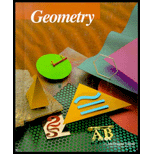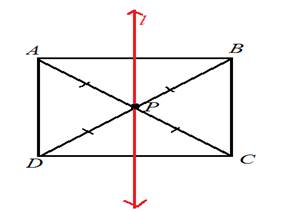
To find: the locus of the points that are equidistance from vertices of given square
Answer to Problem 18WE
Required locus is the perpendicular bisector of diagonals of given square.
Explanation of Solution
Given information: Any square
Concept used: Diagonals of a square bisect each other so that this intersecting point always remains at the equal distance from all its four vertices and if this point starts moving following the given condition, it will actually be a perpendicular that passes from this intersecting point of both diagonals as shown in below figure,

Locus of point P that always remains at equal distance from its vertices will be the red line that is perpendicular to the plane of the square and passes through the intersecting point of diagonals.
Chapter 10 Solutions
McDougal Littell Jurgensen Geometry: Student Edition Geometry
Additional Math Textbook Solutions
Thinking Mathematically (6th Edition)
College Algebra with Modeling & Visualization (5th Edition)
Calculus: Early Transcendentals (2nd Edition)
Elementary Statistics
Intro Stats, Books a la Carte Edition (5th Edition)
Pre-Algebra Student Edition
- 2arrow_forwardCan someone help me with this please?arrow_forwardMariela is in her classroom and looking out of a window at a tree, which is 20 feet away. Mariela’s line of sight to the top of the tree creates a 42° angle of elevation, and her line of sight to the base of the tree creates a 31° angle of depression. What is the height of the tree, rounded to the nearest foot? Be sure to show your work to explain how you got your answer.arrow_forward
 Elementary Geometry For College Students, 7eGeometryISBN:9781337614085Author:Alexander, Daniel C.; Koeberlein, Geralyn M.Publisher:Cengage,
Elementary Geometry For College Students, 7eGeometryISBN:9781337614085Author:Alexander, Daniel C.; Koeberlein, Geralyn M.Publisher:Cengage, Elementary Geometry for College StudentsGeometryISBN:9781285195698Author:Daniel C. Alexander, Geralyn M. KoeberleinPublisher:Cengage Learning
Elementary Geometry for College StudentsGeometryISBN:9781285195698Author:Daniel C. Alexander, Geralyn M. KoeberleinPublisher:Cengage Learning

